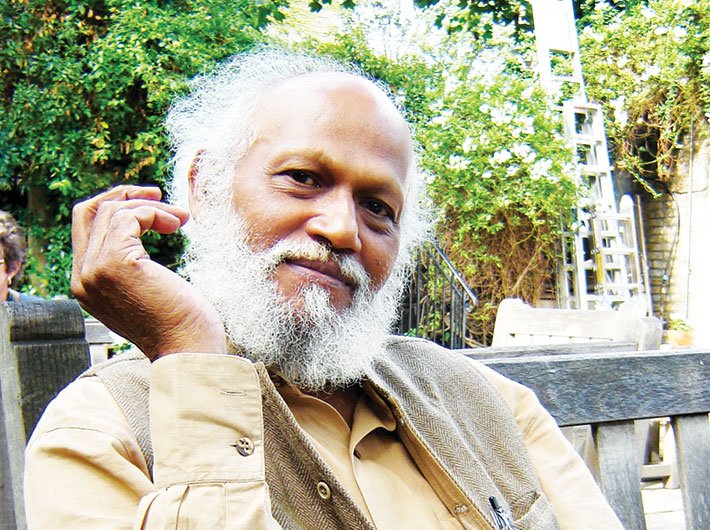When not painting, celebrated Indian artist Jatin Das is busy researching for a series of projects. In between he likes to have a cup of strong coffee and listen to classical music gifted to him by his close friend, photographer Raghu Rai. His studio in Mehrauli, in south Delhi, is spread over two floors and eight rooms for his work of decades. Awarded the Padma Bhushan in 2012, Das has participated in major national and international shows and also lectured in some of the top art institutes in India and abroad. In 1997, he founded the JD Centre of Art in Odisha to house his collection of traditional and contemporary art. He spoke to Puja Bhattacharjee about the challenges and prospects of art in India and his future projects.
What has gone wrong with art in India?
In India art was a way of life in the ancient times. After the colonial period India has gone through a lot of changes. We are disconnected from our culture, philosophy, heritage and ancestry. Are kids today aware of their family lineage? We do not have a sense of historicity. The process starts at the level of an individual and then builds up a collective.
Art can be found in every nook and cranny of European cities. Why is the situation so different in Asia and particularly the Indian subcontinent?
Let us not compare Europe and Asia. They are two very different cultures. Europe has gone through wars. We have gone through natural calamities like floods and earthquakes. If your family has suffered a war and has lost family members, you develop compassion and tenderness. At the moment we are lost souls. We are after jobs, money and material happiness. The western world is regretting materialism that has seeped in their culture. But we are aping the superficial aspects of their materialism. Have you ever heard a child saying I want to be a poet; I want to travel into the forests of India or study tribals? Today people are either downloading information from the internet or sitting in the library and copying it. What stops them from exploring?
Would you say that pursuing art is difficult in our country?
When someone tells their family that they want to pursue art, they are dissuaded; they say there is no money in it, how will you survive? But if the person has passion, interest and talent, they will persevere. I, at the age of 17, went to Bombay from Mayurbhanj district in Orissa to study art. The admission to the art course was over. So I took admission in architecture. After some time, the dean of the faculty of fine arts found my sketches very good and gave me admission. If an individual has a deeper search then they are bound to find it. Everybody is born with some talent. Your parents, teachers and friends should encourage you at what you are good at and what excites you.
When did you discover you wanted to be an artist?
I did not know I wanted to be an artist. I wanted to draw and paint. We had a big garden with 300 varieties of plants. I spent my childhood in the garden modelling clay, drawing and swimming in the river. Fortunately I had a very good guru. Mayurbhanj was an enlightened and cultured place.
What are you working on now?
I have a vision for a book on Mayurbhanj. It was an old princely state. The first streetlights of Orissa were in Mayurbhanj, as was the first telephone, an electric powerhouse and a water purifier plant. All the great laureates came to Mayurbhanj. They had an airport of their own. They had an army, police and musical programmes once in a year. I have collected archival material on Mayurbhanj from the British Library. Then I engaged two people and got almost 3,000 pages on Mayurbhanj from the national and state archives in Bhubaneswar. Now I have to get information from the district archive. I also need someone in Kolkata to cull out information from the Asiatic Society and the national geological department. After that I will give the material to a couple of scholars to research. The book will cover tribal, mineral and culture. A lot of work has been done on it for 10 years. Now time has come to round it up and produce it. Then Raghu Rai, a close friend, will go to Mayurbhanj and take photographs.
I also plan to write a book on Dom Moraes, also a close friend. The idea is not [to generate] publicity but to reminisce a friend. I recently shifted my studio. While shifting, I found more than 1,000 portrait sketches of my artist friends. I am planning to do a book on friends and portraits.
What challenges do you face?
Some people are very lucky. They get people who will drop everything to come and work with them. I do not have a dedicated team yet.
In your opinion how can our system encourage art?
In our society people know doctors, engineers, politicians, professors and maybe writers. People do not know what a poet or a painter is. Even an engineer should know how to draw. Dr Homi Bhaba used to paint every day. Art is intricately associated with our lives. In every school there should be handicraft, handloom, poetry, dance, music and science. You can teach science through art. We have not invested enough in our education. At the turn of the century there was a lot of upsurge. A lot of people have talent but under various circumstances it does not get encouraged. I am lucky to have continued.
Did you have to struggle before you got recognition as an artist?
Struggle has been all along and it will continue. Struggle is not only about food and shelter. Struggle is omnipresent in life and at work. Struggle can be at a spiritual level, struggle in words or in thought process. So you compromise in day-to-day living.
Who or what is your role model? How do you feel when your work is sold?
I think of Konark, Khajuraho and Mahabalipuram as my role models. I paint with my heart and soul. When a painting is sold, I feel grief-stricken. I live only on the sale of my work but I don’t paint for selling. This is a never-ending conflict.
What is the best way to learn about art?
The best way to learn is by being an apprentice to an artist. Art schools in India focus mainly on western art and too much theory. Then again aspiring artists should have perseverance to dedicate themselves completely to learning. The concept of my country is that the process is important, not the final product.
Many a time artists get into trouble for their work. At the same time, art is self-expression. What is your opinion?
When you look at a painting, you should look at it without any preconceived notion. People come with a lot of baggage. I feel people should look at the work simply and innocently instead of being judgmental. Just be vulnerable and approach life simply.
What is your most memorable moment?
About a decade ago, I was working in Park Street. A dhoti-clad man clutching an umbrella under his arm approached me and asked, ‘Aren’t you Jatin Das?’ When I said yes, he said, ‘Amar jibon sarthak hoye gelo (My life’s purpose has been fulfilled)’.
puja@governancenow.com
(The interview appears in the November1-15, 2015 issue)

